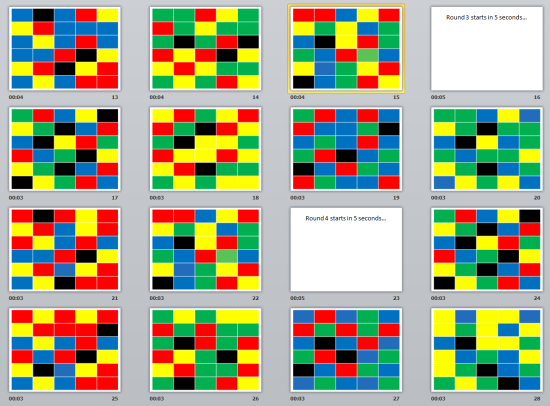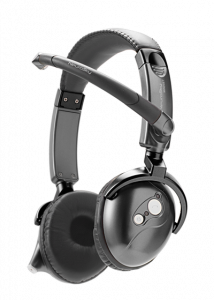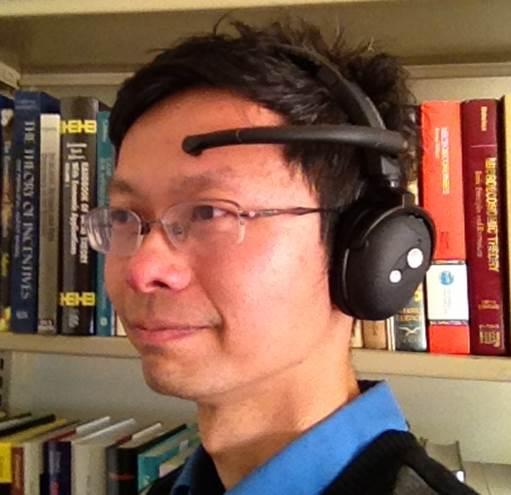The participants from the Fall 2014 Info 290 class are sharing with the research community a first-of-its-kind dataset collected using consumer-grade brainwave-sensing headsets during an in-class group exercise, along with the software code and visual stimulus used to collect the data. The dataset and documentation are available at https://bit.ly/synchronized-brain-recordings.
The release coincides with the 20th annual Brain Awareness Week for brain research.
The group exercise was a “Color Counting Challenge” where the 25 students in the class were presented with a visual stimulus (duration 162 seconds) consisting of a timed sequence of images with colored rectangles arranged in a 5x6 matrix. The rectangles were colored in red, green, blue, yellow, and black, with varying numbers of rectangles of each color on each image. At the start of the exercise, each participant was asked to select a color (red, green, blue, or yellow). Then each participant silently counted the number of rectangles of their chosen color as each image is displayed on the projector screen.
Brainwave signals were collected from each participant using Neurosky Mindwave Mobile devices. The data was transmitted over a Bluetooth connection to a software client installed on each participant’s notebook computer, and then forwarded to a networked server for storage. The dataset was anonymized using a four-step process before being released, to protect the confidentiality of participants.
“As a class, we talked extensively about the value of data sharing as well as the importance of data stewardship,” said professor John Chuang. “I am most excited that we have come up with a novel way to support the enthusiasm of the class to contribute a unique piece of data to science while safeguarding the confidentiality of individual contributors.”
Chuang is hopeful that the dataset — along with the software and methodology for conducting the experiment — will prove useful for other brain researchers. The dataset could help answer whether it’s possible to accurately use consumer-grade devices to interpret attention level in a problem-solving test. “In general, this is a rather difficult task,” said Chuang, “but perhaps we can use quantity to compensate for quality.”
Today’s data release demonstrates that it’s possible to collect this kind of research data in bulk. “Traditionally, this kind of data is expensive to collect,” Chuang explained, because it requires measuring subjects individually in high-end research labs with complicated and invasive equipment. “But if we can do this with 25 people at a time, then why not two hundred? Or two thousand?”
Because the class is sharing the complete experimental package, including the data-collection software, stimulus files, and detailed experimental methodology, Chuang is hopeful that other researchers will be able to repeat the experiment with even larger subject pools, to increase the size of the research dataset.
He also hopes researchers find new and creative uses for the data and methodology. “You never know what it might be useful for.”
Brain Awareness Week
Brain Awareness Week is observed March 16–22, 2015, to celebrate and increase public awareness of the progress and benefits of brain research. Brain Awareness Week was launched in 1995 by the Dana Alliance for Brain Initiatives, in partnership with the Society for Neuroscience and other brain research organizations. The week highlights progress in brain research as well as in the diagnosis, treatment, and prevention of disorders of the brain, such as Alzheimer’s, Parkinson’s, stroke, schizophrenia, and depression.
Info 290 course: Sensors, Humans, Data, Apps
The course Info 290. Sensors, Humans, Data, Apps takes a hands-on approach to exploring the possibilities and limitations of consumer-grade bio-sensing technologies for brainwave, heart rate, body movement, and other physiological and contextual data.
Just as the web browser brought us click-stream data and the mobile phone brought us geo-location data, ubiquitous low-cost bio-sensors integrated with wearable computing devices will bring us a new torrent of consumer bio-data to collect, analyze, and exploit.
In the course, students survey the literature on the analysis and visualization of bio-data and the design and evaluation of applications that leverage bio-data. Students collect and analyze their own bio-data using a variety of devices. They consider new business models and data stewardship issues, including data ownership and data privacy. Student projects come from a variety of application domains, such as affective computing, bio-feedback, context-aware security, e-commerce, neuro-marketing, privacy by design, quantified self, sentiment analysis, and user interface technologies.
The course will be taught again in Fall 2015.













